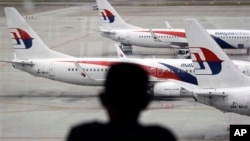The International Air Transport Association is calling 2014 the safest year ever for commercial aviation. The association says there were fewer serious accidents last year than at any time in the history of flight. Yet the aviation industry also had several well-publicized crashes that killed many people.
The International Air Transport Association says 3.3 billion airplane passengers completed safe flights last year. Yet the association, known as IATA, says the number of deaths in air accidents was above the average of recent years.
The group reported that in terms of planes lost because of "hull losses" it was the safest year on record. A hull loss is an accident in which the aircraft is destroyed or damaged so severely that it cannot be repaired.
The chief executive officer of IATA, Tony Tyler, spoke to reporters in Hong Kong. The association represents about 250 airline companies. He characterized 2014 as a year of contrasts for aviation safety.
"We did have some very high profile, very tragic accidents and in fact we had three jet hull losses which caused loss of life and so it was certainly a year where airline safety was very much in the headlines. However, when we look at the picture as a whole, it was in fact a year when air safety improved quite significantly and in fact only one flight in every 4.4 million had an accident resulting in hull loss."
However, IATA’s statistics do not include the loss of Malaysia Airlines Flight 17 last July. Pro-Russian separatist fighters are believed to have shot down the airplane near Russia’s border with Ukraine. All 238 passengers and crew members were killed. That crash was not considered an accident because a missile reportedly struck the plane down.
One of aviation's biggest unsolved mysteries took place last year. A year ago, Malaysia Airlines Flight 370 disappeared on its way to Beijing. The flight veered off its course after leaving Kuala Lumpur, the Malaysian capital. Officials believe the plane went down in the southern Indian Ocean, far off Australia's western coast. But no physical evidence of the crash has ever been found.
Tony Tyler says that after the MH 370 incident, the whole industry is united in finding a better way to monitor or track aircraft.
"And we need to make sure that those ways are developed and implemented as soon as we can."
IATA says there were 12 deadly accidents last year, with a total of 641 deaths. The aviation industry had an average of 19 deadly crashes, with 517 deaths, in each of the past five years.
Besides the two Malaysia Airlines incidents, other major accidents last year included a crash in Mali of an Air Algeria flight during bad weather. That crash killed 116 people. And an Air Asia flight went down in the Java Sea. There were no survivors among the 162 passengers and crew.
Nine of the 12 deadly crashes last year involved turboprop planes, which are powered by propellers. They have a higher accident rate than jets.
IATA says it wants to make flying safer and has offered a six-point safety plan. The idea is to reduce risk. Some of the measures IATA supports include improving aviation centers and technology, and better training for crews. It also calls for identifying safety concerns as they develop such as issues related to lithium batteries on aircraft.
I’m Mario Ritter.
VOA Correspondent Steve Herman prepared this report. Mario Ritter wrote it for VOA Learning English. George Grow was the editor.
_____________________________________________________________
Words in This Story
aviation - n. the business or exercise of flying airplanes, helicopters, etc.
characterized - v. to describe the qualities of (someone or something)
statistics - n. a number that represents a piece of information (such as information about how often something is done, how common something is, etc.)
veer - v. to change direction quickly or suddenly
How do you feel about flying? Let us know in the comment section below.







